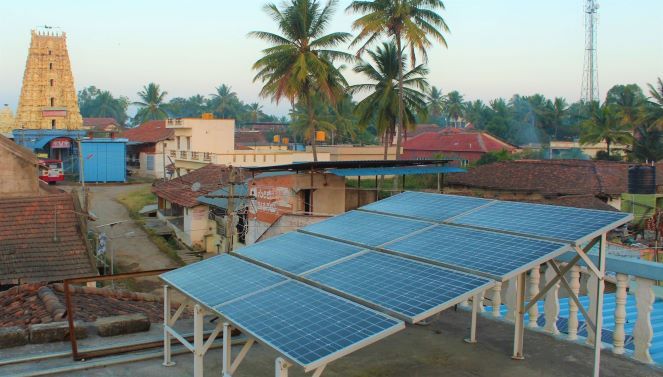Solar Electricity- Need of the Hour
Mankind’s survival is primarily dependent on Energy source. The quest for energy source is since centuries. Exploration of Energy sources has always involved in better understanding of nature. Though the nature’s challenges for human existence have been overcome with successful technology deployment of energy generation, this has lead to a greater failure as climate change. The dependency on fossil fuel is causing untold danger to the climate and threat to the environment. The explosive nature of Energy demand is impacting on the climate which leaves a question on survival of our future generation. The threat of Energy shortage and climate damages need to be addressed on Urgent priority. It is very essential to accelerate the replacement of fossil fuels with renewable Energies.

The route to avoid climate chaos and achieve energy independence to develop sustainable environment and foster a healthy world for our future generation is very much required. Without fundamental changes in how we generate and how we use Energy, the challenges threaten our livelihood and our planet. Towards this, renewable Energy sources require utilization to its fullest available resources. The Solar Energy is one of those sources which is more predictable, reliable and harnessable. The sun shines in abundance over India and a part of it is enough to meet the whole demand of the country if tapped in full. The best way to utilize this source of Energy is to feed the Electricity generation from Solar Energy to Distribution Grid which can reach the utility and meet the various needs of the society.
For every hundred unit of electricity that we use, an equivalent of eighty-five kilograms of Carbon is emitted from Thermal Power Plant which means that a tree is burnt to produce hundred units of electricity. So, an average household consumption of 150-200 units a month will require 12 to 15 trees per year to make this up. Electricity consumption alone is a slow poison to our own future generation and pushing them to unforeseen climatic challenges and health issues. The best way is to switch to a greener energy source like solar.

How does Solar Power on our roof’s work? ……..
The solar panel produces DC power. Multiple solar panels are coupled together as arrays which produce higher DC voltage. The DC power is converted to Grid compatible AC power. This power is fed to our home utility and grid. As long as the Solar power is generated, the power is either consumed by the utility or flows out to the grid. The Grid will act as a make-up tank of either supplying the load or consuming solar power. The Energy meter will read both ways of power unlike the existing energy meters which read only one way thereby enabling the user to export or import power of solar with utility grid.
Solar Rooftop is categorized as two general types: For small scale application (up to few kilowatts) and for large scale power generation (Mega Watt Scale). The small-scale PV system (mostly useful for home) can have two type of system such as Grid interactive only (with out any battery) and Grid interactive with battery backup. The direct Grid interactive system operates when the utility is available. This is useful where the utility outages are rare. In the event of outages by utility, the PV system shutdown till the utility power is restored. The grid interactive with Battery backup incorporate Energy storage in the form of a battery to keep critical loads circuits in the home operating during the utility outage. When the outage occurs the unit disconnects from the utility and power specific circuits. During the availability of utility, the power generated is fed to the home loads or to the grid. There can be a log of energy pumped to the grid, Energy consumed and the Energy Generated. This is called Net metering where in, the net of energy generation Vs energy pumped or drawn from grid is recorded. This enables the user to record net of energy pumped to or drawn from the grid. The Photovoltaic Power Generation systems can provide most reliable output for a longer period. The regular cleaning of PV modules can eliminate reduction in power generation loss due to dust and dirt factor. Eventhoug there is no moving parts in the power plant, a properly ventilated area with dust filter for Power Conditioner Unit can ensure a longer performance of the system. In general, the attractive attributes of the PV system are its low maintenance.
The technology costs are becoming more competitive day by day. With volumes, the cost can be more meaningful in making this noble energy source a best way of energy generation. The Return on Investment can be expected in less than 7 years while the Solar Power can be enjoyed over 25 years. The Local Electricity supply companies will sign a Power Purchase Agreement which will mandate them to buy excess generated solar power at a predetermined tariff (at present it is around Rs.4/kWhr). The future of our electricity supply will solely depend on Solar Power and hence it is wise to install now as the policies are in consumer’s favour. There is no Tax on solar electricity and for corporates, the depreciation and GST benefits can make the returns earlier. There are few states in India which have already started taxing solar power. It is likely that, with increased installation of solar rooftop, the Electricity companies will burden the consumer of surcharge on solar power. Solar rooftop can go in real terms more meaningful green farming and harvest a bright future for our future generation. India is blessed with abundant sunshine and the realization of our dreams on Environmental concern and free electricity can be best achieved with Solar Rooftop Systems.

